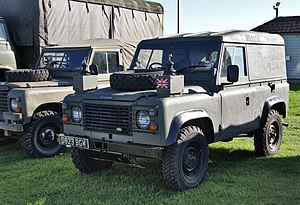| Mullaghcreevie ambush | |||||||
|---|---|---|---|---|---|---|---|
| Part of The Troubles and Operation Banner | |||||||
 A British Army Land Rover Defender | |||||||
| |||||||
| Belligerents | |||||||
|
|
(Ulster Defence Regiment) | ||||||
| Strength | |||||||
| 1 active service unit | 1 mobile patrol | ||||||
| Casualties and losses | |||||||
| none |
2 soldiers killed 2 wounded 1 vehicle destroyed | ||||||
Location within Northern Ireland | |||||||
The Mullacreevie ambush took place on 1 March 1991, when a mobile patrol of the Ulster Defence Regiment composed of two Land Rover vehicles was attacked by a Provisional IRA active service unit with an improvised horizontal mortar while passing near Mullacreevie housing estate, on the west side of Armagh City. One member of the UDR was killed instantly when the leading Land Rover was hit, while another died of wounds two days later. Two other soldiers were permanently injured.
IRA Improvised horizontal mortars[]
According to author Tony Geraghty, British authorities learnt of the first horizontal mortar produced by the Provisional IRA, the Mark 12, in 1985. The weapon was recovered after a deadly incident in which three IRA volunteers were killed by security forces. The launcher suffered from the limitation of a heavy recoil, which made the handling of the device difficult. One British intelligence report say that while the launcher was quite crude, the grenade was made of “a number of components which require a high standard of machine manufacturing.” The projectile had a warhead of 40 ounces (1.1 kg) of semtex and TNT. It was used basically as a standoff weapon, in which the grenade was lofted over the security bases’ fences or against armoured vehicles.[1] The mortar had an effective range of 70 yards, within which it could pierce an armour plate or destroy a sangar.[2]
Later in the conflict they developed the Mark 16, a new version with improved armour piercing capabilities, usually referred to as a “projected recoilless improvised grenade”.[3]
The ambush[]
On the evening of 1 March 1991, a two-vehicle mobile patrol belonging to the 2nd Battalion of the Ulster Defence Regiment was approaching the western outskirts of Armagh city on Killylea road.[2] When driving along Mullacreevie housing estate,[4] the two Land Rovers were held by temporary traffic lights at roadworks.[2] Unknown to them, the IRA had set a Mark 12 launcher on a hump of earth in the front garden of a house besides the lights.[4] After the incident, IRA sources depicted the device as a “directional missile”.[5]
When the first Land Rover pulled off after the lights turned green,[2] the mortar ‘s improvised grenade was fired by command-wire from the backyard of the house[4] by IRA members concealed behind a digger.[6] The projectile hit the coachwork, blowing away both sides and the roof of the military vehicle.[2] Witnesses reported that the Land Rover was “ripped apart”.[7] The soldiers inside were immediately assisted by fellow UDR members, who helped to drag the wounded out of the shattered wreckage.[2]
Private Paul Sutcliffe, a 32-year old Englishman who had served for four years with the Duke of Wellington’s Regiment before becoming a UDR soldier in 1989, died on the spot. The driver, Private Roger Love, a 20-year old from Portadown, succumbed to his injuries three days later.[4] Two other servicemen were maimed by the explosion. One of them suffered severe chest wounds, and lost the use of one arm, wile the other had a leg amputated below the knee.[2]
The ambush at Mullacreevie was the first time that a Mark 12 mortar was used successfully.[2]
Aftermath[]
Roger Love’s family donated the deceased soldier’s kidneys after they authorized the medical staff to disconnect the life-supporting machine. A UDR party attended Paul Sutcliffe’s funeral at his hometown of Barrowford, Lancashire, the only UDR military funeral held outside Northern Ireland.[2] His ashes were scattered on Mourne mountains.[4]
Another horizontal mortar attack on a UDR mobile patrol took place on 6 November, when Private Michael Boxall was killed in Bellaghy after the Land Rover he was riding on was hit by a Mark 12 grenade. A fellow soldier lost one eye in the attack.[8]
The Mark 12 mortar was used by the IRA until 1993, when it was superseded by the Mark 16. The Mark 16 was fired on eleven occasions by the IRA[9] from late 1993 to early 1994.[10]
Notes[]
- ↑ Geraghty 1998, p. 195
- ↑ 2.0 2.1 2.2 2.3 2.4 2.5 2.6 2.7 2.8 Potter (2008), p. 350
- ↑ Geraghty 1998, p. 196
- ↑ 4.0 4.1 4.2 4.3 4.4 McKittrick (2000), p. 1227
- ↑ Fortnight. Issues 291-301, p. 22
- ↑ "In Loving Memory of UDR Private Roger Love". http://www.udr.talktalk.net/love.html. Retrieved 24 November 2014.
- ↑ McCaffery, Steven (2 May 2006). "Terrible legacy of the past". http://www.nuzhound.com/articles/irish_news/arts2006/may2_terrible_legacy.php. Retrieved 24 November 2014.
- ↑ Potter (2008), p. 351
- ↑ Oppenheimer and English (2009), p. 238
- ↑ "Operation Banner". http://www.operationbanner.com/roh/CommentView.asp?who=105#prof. Retrieved 24 November 2014.
References[]
- McKittrick, David; Kelters, Seamus; Feeney, Brian; Thronton, Chris (2000). Lost Lives. Mainstream Publishing, ISBN 1-84018-227-X
- Geraghty, Tony (2000) The Irish War, Baltimore: Johns Hopkins University Press, ISBN 0-00-255617-0
- Oppenheimer, A. R. (2009). IRA: The Bombs and The Bullets. A History of Deadly Ingenuity. Irish Academic Press, p. 127. ISBN 978-0-7165-2895-1
The original article can be found at Mullacreevie ambush and the edit history here.
